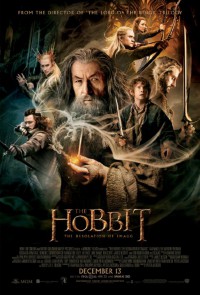 It struck everyone as odd when Peter Jackson announced he was making the slim, 300-page novel of The Hobbit into three 3-hour motion pictures. The first film, while strong, was still flawed and proved what everyone feared. The second film, while faring a little better, proves that turning a simple tale into a bloated monster wasn’t necessarily the best move.
It struck everyone as odd when Peter Jackson announced he was making the slim, 300-page novel of The Hobbit into three 3-hour motion pictures. The first film, while strong, was still flawed and proved what everyone feared. The second film, while faring a little better, proves that turning a simple tale into a bloated monster wasn’t necessarily the best move.
Following a brief prologue, the film picks up right where the first installment ended. The hobbit Bilbo Baggins, the band of Dwarves, and Gandalf the Gray, are still en route to Erebor, to reclaim the Dwarves’ homeland from a possessive, deadly dragon. On their way they encounter wood elves, Orcs, skinchangers, and a mysterious necromancer…all culminating in the final, remarkable unveiling of the dragon, Smaug.
The biggest problem with the film is that it is, indeed, a bloated monster. The novel these films are based on—Tolkien’s The Hobbit, a modern fairy tale if there ever was one—was a simple story that was a nice introduction to his “imaginary world,” as he once put it. Peter Jackson, in an attempt to link this film with The Lord of the Rings, brings in a much darker sensibility. Whereas the book was lighthearted and fun, this film is dark, grim, and the humor is black. There is also a lot that happens; it’s not necessarily too much, but not all of it is interesting (especially Gandalf’s side story involving Sauron’s return). In other words: there was a reason Tolkien included these segments in the appendixes.
The film is solidly made. The acting is superlative, as can be expected from a cast of this caliber. Martin Freeman excels at Bilbo Baggins, bringing the character to life from the written page. There is nothing else that can be said of Ian McKellen—he is brilliant, as always. The supporting cast—from the company of Dwarves to the citizens of Laketown—do their best to inhabit characters that the screenplay often treats as throwaway cardboard cutouts. They’re wooden planks that speak melodramatic lines that, in such a digitized world, feel fake.
The production design, sound effects, and visual effects are all masterfully done—but this element is also a stumbling block for the film. It becomes a video game. The last hour—an elongated battle with Smaug—feels tedious and annoying after a while. There’s no reason for it to exist, and to be so long-winded; everyone in the audience started squirming and checking their watches during this segment.
On that note: Smaug is a wonder to behold, but the filmmakers should have showed a bit more restraint. The scene derived directly from the book, where Bilbo and Smaug have a small battle of wits, is wonderful. Smaug is slowly revealed: a mountain of gold uncovers an eye, then his tail, thus showing you his full length; his eye opens, and he rises from the gold, and for a while all you see is his head…then he unveils himself, in all his terrifying glory. Benedict Cumberbatch, who voices Smaug, embodies the character as Andy Serkis did with Gollum.
But that battle of wits becomes a true battle, and this last hour of the film is, frankly, its weakest point. The screenplay makes a five-minute fight into an hour long spectacle that leaves you bored. The camera swoops and characters fly and dragons roar…but after that hour, nothing is achieved. And the real ending happens on such an abrupt note. Granted, there wasn’t a better place to end the film anyway…but that fact should’ve been a warning to the filmmakers:
“Why are there three of these movies?”
—————————
For More Information Visit:
—————————
http://www.imdb.com/title/tt1170358/externalreviews